
Coorg orange, also called Coorg mandarin, is a cultivar of orange from Kodagu in Karnataka. It was given the Geographical Indication status in 2006.

Coorg orange, also called Coorg mandarin, is a cultivar of orange from Kodagu in Karnataka. It was given the Geographical Indication status in 2006.
In the 1960s, Coorg orange was grown in land of 24,000 hectare area. In recent years the cultivation area has come down to less than 2,000 hectares. [1] Coorg orange was mainly cultivated in the districts of Kodagu, Hassan and Chikmagalur as a secondary crop in coffee plantations for more than 150 years. [2] [1]
Coorg oranges are regarded as man-made hybrids of mandarins ( Citrus reticulata ). [3] Greenish-yellow in colour, they have a tight skin and a sweet-sour taste, unlike Nagpur oranges which are known to have loose skin and sweet taste. [1] Coorg oranges are said to have longer shelf life compared to other varieties. [4] The hilly terrain with well-drained soil and heavy rainfall in the region of cultivation are regarded as the reasons for the unique characteristics of this variety. [5]
Coorg orange cultivation has decreased in recent years due to diseases, emergence of Nagpur orange, among other factors. [6] The yield of each plant has come down to around 10kg which was once more than 50kg. [1] The average production of the fruit is over 45,000 tonnes. [7]

Kodagu district is an administrative district in the Karnataka state of India. Before 1956, it was an administratively separate Coorg State, at which point it was merged into an enlarged Mysore State.

The pomelo, Citrus maxima, is the largest citrus fruit from the family Rutaceae and the principal ancestor of the grapefruit. It is a natural, non-hybrid, citrus fruit, native to Southeast Asia. Similar in taste to a sweet grapefruit, the pomelo is commonly consumed and used for festive occasions throughout Southeast Asia. As with the grapefruit, phytochemicals in the pomelo have the potential for drug interactions.

The Kodava people or Kodavas are an ethno-linguistic group from the region of Kodagu in the southern Indian state of Karnataka, who natively speak the Kodava language. They are traditionally land-owning agriculturists and patrilineal, with martial customs. Kodavas worship ancestors and weapons. They used to worship swords, bows, arrows and later guns. Hence, Kodavas are the only ones in India permitted to carry firearms without a license.
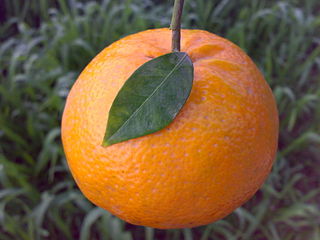
The Kinnow is a high yield mandarin hybrid cultivated extensively in the wider Punjab region of India and Pakistan.

Byadagi chilli is a variety of chilli mainly grown in the Indian state of Karnataka. It is named after the town of Byadgi which is located in the Haveri district of Karnataka. It is sometimes written as Bedgi in some super markets and grocery stores in India. The business involving Byadagi chillis has the second largest turnover among all chilli varieties of India. An oil, oleoresin, extracted from these chillies is used in the preparation of nail polish and lipstick. Byadagi chilli is also known for its deep red colour and is less spicy and is used in many food preparations of South India. Byadagi chilli has been accorded Geographical Indication (GI) in February 2011. Its GI tag is 129.

Banganapalle mangoes is a mango variety produced in Banganapalle of Nandyal District in the Indian state of Andhra Pradesh. It alone occupies 70% percent of total mango cultivable area of the state and was first introduced by the Farmers of Banaganapalli. It was registered as one of the geographical indication from Andhra Pradesh on 3 May 2017, under horticultural products by Geographical Indication Registry. It is also grown in the other parts of India and Pakistan. The fruit is described as obliquely oval in shape, around 20cm in length, with yellow flesh and a thin, smooth yellow skin. The flesh is of a firm, meaty texture and is sweet and lacks fibre. The cultivar is the most sought after in Andhra Pradesh. It is a very late -season variety that is good for canning. This cultivar is a source of vitamin A & C and is also called king of Mangoes.

Coffee production in India is dominated in the hill tracts of South Indian states, with Karnataka accounting for 71%, followed by Kerala with 21% and Tamil Nadu. Indian coffee is said to be the finest coffee grown in the shade rather than direct sunlight anywhere in the world. There are about 250,000 coffee growers in the country; 98% of them are small growers. As of 2009, Indian coffee made up just 4.5% of the global production. Almost 80% of Indian coffee is exported; 70% is bound for Germany, Russia, Spain, Belgium, Slovenia, United States, United Kingdom, Japan, Greece, Netherlands and France. Italy accounts for 29% of the exports. Most of the export is shipped through the Suez Canal.

The lemon is a species of small evergreen trees in the flowering plant family Rutaceae, native to Asia, primarily Northeast India (Assam), Northern Myanmar or China.
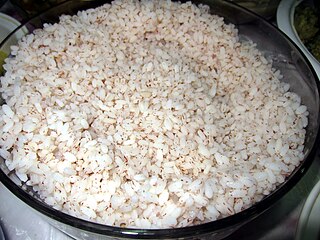
RoseMatta rice is an indigenous variety of rice grown in the Palakkad district of Kerala, India. It is known for its coarseness and health benefits. It is popular in Kerala and coastal Karnataka in India and Sri Lanka where it is used on a regular basis for idlies, appams and plain rice; it is different from brown rice. The robust and earthy flavour of Red Matta makes it suitable to accompany lamb, beef or game meats.
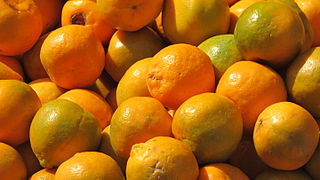
Nagpur orange is a variety of mandarin orange grown in Nagpur, Maharashtra, India.

Tirupati Laddu or SriVari Laddu is the laddu sweet offered as Naivedhyam to Venkateswara at Tirumala Venkateswara Temple in Tirupati, Tirupati district, Andhra Pradesh, India. The laddu is given as prasadam to devotees after having the darshan in the temple. The laddu prasadam is prepared within the temple kitchen known as 'Potu' by the temple board Tirumala Tirupati Devasthanams. Tirupati Laddu received Geographical indication tag which entitles that only Tirumala Tirupati Devasthanams can make and sell it.
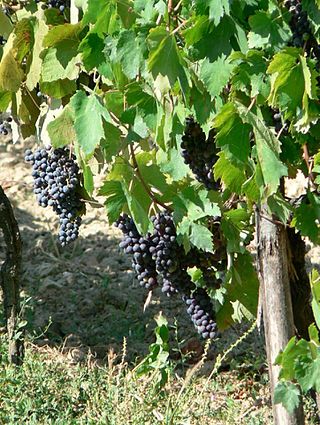
Bangalore blue grape, also simply called Bangalore Blue, is a variety of fox grape grown in districts around Bangalore in India. It is one of the three major varieties of grape in the state of Karnataka. It received a geographical indication tag from the Government of India in 2013.

Udupi Mattu Gulla, or Udupi Matti Gulla, is a variety of green brinjal grown in and around the village of Matti in Udupi, India. It was given the Geographical Indication tag in 2011.
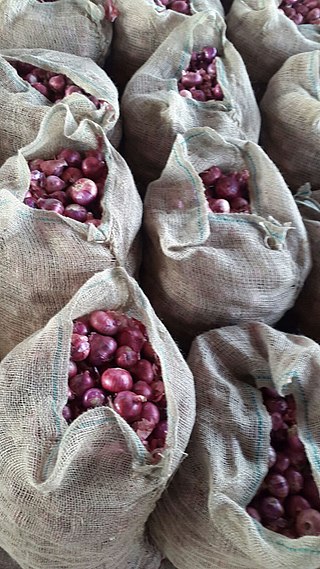
Bangalore rose onion, locally called gulabi eerulli, is a variety of onion grown in and around Bangalore in Karnataka. It got the Geographical Indication tag in 2015.

Kangra tea is a tea from the Kangra district in Himachal Pradesh, India. Both black tea and green tea have been produced in the Kangra Valley since the mid-19th century. Kangra tea was given the Geographical Indication status in 2005.

The Nanjangud banana, natively called as Nanjangud rasabalehannu, is a variety of banana grown in and around the area Mysore district and Chamarajanagar district of Karnataka, India. It is famous for its unique taste and aroma. It was found that the black clay alluvial saline soil found in and around Nanjangud drastically changed the taste and aroma, giving it a particular geographical identity, so it is now registered under geographical indicators under Government of India.

The Devanahalli pomelo is a variety of the citrus fruit pomelo of the family Rutaceae. It is exclusively grown in the region around Devanahalli taluk, Bangalore Rural District, India, as an exotic crop variety. Its officially designated name is "Devanahalli Pomello (Chakkota)"; it is locally known as chakkota.
Kamalapur Red Banana is a special variety of Red banana which is exclusively grown in the valley of Kamalapur village and its surrounding areas in Kalaburagi district of Karnataka, India. It is known as a "rich man's fruit" as it is marketed at a higher price compared to other varieties of banana due to greater inputs in farming with fertilizer, water, and workforce. While its skin is red coloured, the pulp is creamish in colour with an enjoyable taste. It has a high calorie value with Vitamin C and B6, which makes it a health food.
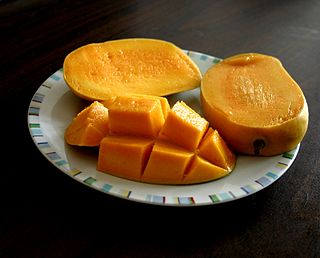
The 'Gir Kesar' mango, also called Kesar, is a mango cultivar grown in the foothills of Girnar in Gujarat, western India. The mango is known for its bright orange colored pulp and was given the geographical indication status in 2011. The biggest market of Gir Kesar is in Talala Gir known as a Mango Market Yard.
Allahabadi Surkha are a variety of guava having deep pink color inside instead of the typical white color and an apple red exterior skin. This fruit is sweet, and strongly flavoured with few seeds and is slightly depressed at both ends. The plants are vigorous, dome shaped and compact. These guavas are cultivated across the Allahabad, Uttar Pradesh region in the northern belt of India. Allahabadi Surkha is cultivated today on almost 1000 hectares of land mainly under Kaushambi and Kaurihar -II districts of Allahabad. The fruit is known for its medical properties such that during the winter season because it neutralizes disease symptoms.